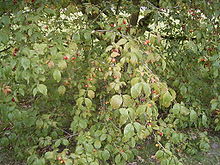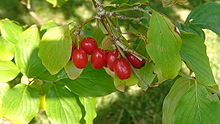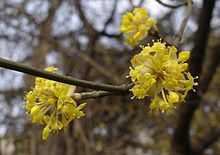- European Cornel
-
European Cornel Branch with fruit Scientific classification Kingdom: Plantae (unranked): Angiosperms (unranked): Eudicots (unranked): Asterids Order: Cornales Family: Cornaceae Genus: Cornus Subgenus: Cornus Species: C. mas Binomial name Cornus mas
L.The European Cornel (Cornus mas) is a species of dogwood native to southern Europe and southwest Asia. In North America, the plant is known by the common name of Cornelian Cherry.
It is a medium to large deciduous shrub or small tree growing to 5–12 m tall, with dark brown branches and greenish twigs. The leaves are opposite, 4–10 cm long and 2–4 cm broad, with an ovate to oblong shape and an entire margin. The flowers are small (5–10 mm diameter), with four yellow petals, produced in clusters of 10–25 together in the late winter, well before the leaves appear. The fruit is an oblong red drupe 2 cm long and 1.5 cm in diameter, containing a single seed.
Contents
Uses
Fruit
The berries when ripe on the plant bear a resemblance to coffee berries, and ripen in mid to late summer. The fruit is edible, but the unripe fruit is astringent. The fruit only fully ripens after it falls from the tree. When ripe, the fruit is dark ruby red. It has an acidic flavour which is best described as a mixture of cranberry and sour cherry; it is mainly used for making jam, makes an excellent sauce similar to cranberry sauce when pitted and then boiled with sugar and orange, but also can be eaten dried. In Azerbaijan and Armenia, the fruit is used for distilling vodka, while in Albania it is distilled into raki. In Turkey and Iran it is eaten with salt as a snack in summer, and traditionally drunk in a cold drink called kızılcık şerbeti. Cultivars selected for fruit production in Ukraine have fruit up to four cm long.
Flowers
The species is also grown as an ornamental plant for its late winter flowers, which open earlier than those of forsythia, and, while not as large and vibrant as those of the forsythia, the entire plant can be used for a similar effect in the landscape.
Wood
The wood of C. mas is extremely dense, and unlike the wood of most other woody plant species, sinks in water. This density makes it valuable for crafting into tool handles, parts for machines, etc.[1] Cornus mas was used from the seventh century BC onward by Greek craftsman to construct spears, javelins and bows, the craftsmen considering it far superior to any other wood.[2] The wood's association with weaponry was so well known that the Greek name for it was used as a synonym for "spear" in poetry during the fourth and third centuries BC.[2] In Italy, the mazzarella, uncino or bastone, the stick carried by the butteri or mounted herdsmen of the Maremma region, is traditionally made of cornel-wood, there called crognolo or grugnale, dialect forms of Italian: corniolo.[3]
The red dye used to make fezzes was produced from its bark and tannin is produced from its leaves.[citation needed]
Garden history
Cornus mas, the Male Cornel, was named to distinguish it from the true Dogberry, the Female Cornel, C. sanguinea, and so it appears in John Gerard's Herbal. The shrub was not native to the British Isles. William Turner had only heard of the plant in 1548,[4] but by 1551 he had heard of one at Hampton Court Palace.[5] John Gerard said that it was to be found in the gardens "of such as love rare and dainty plants" and by the 17th century, the fruits were being pickled in brine or served up in tarts.
The appreciation of the early acid yellow flowers, of little individual interest, is largely a 20th-century development.[6] The Royal Horticultural Society gave Cornus mas an Award of Merit in 1924.
References and notes
- ^ Demir, F.; Hakki Kalyoncu, I. (December 2003). "Some nutritional, pomological and physical properties of cornelian cherry (Cornus mas L.)". Journal of Food Engineering 60 (3): 335–341. doi:10.1016/S0260-8774(03)00056-6. "The wood is heavier than water and does not float, therefore it is used for tools, machine parts, etc."
- ^ a b Markle, Minor M., III (Summer 1977). "The Macedonian Sarrissa, Spear and Related Armor". American Journal of Archaeology 81 (3): 323–339. doi:10.2307/503007. JSTOR 503007.
- ^ "Il Buttero" (in Italian). Associazione Butteri d'Alta Maremma. http://www.butteri-altamaremma.com/italiano/buttero.htm. Retrieved July 2011.
- ^ Turner, The Names of Herbes, 1548; noted in Alice M. Coats, Garden Shrubs and Their Histories (1964) 1992, .s.v. "Cornus".
- ^ Turner, A New Herball, 1551, noted in Coats.
- ^ Coats (1964) 1992.
See also
External links
Wikimedia Foundation. 2010.



